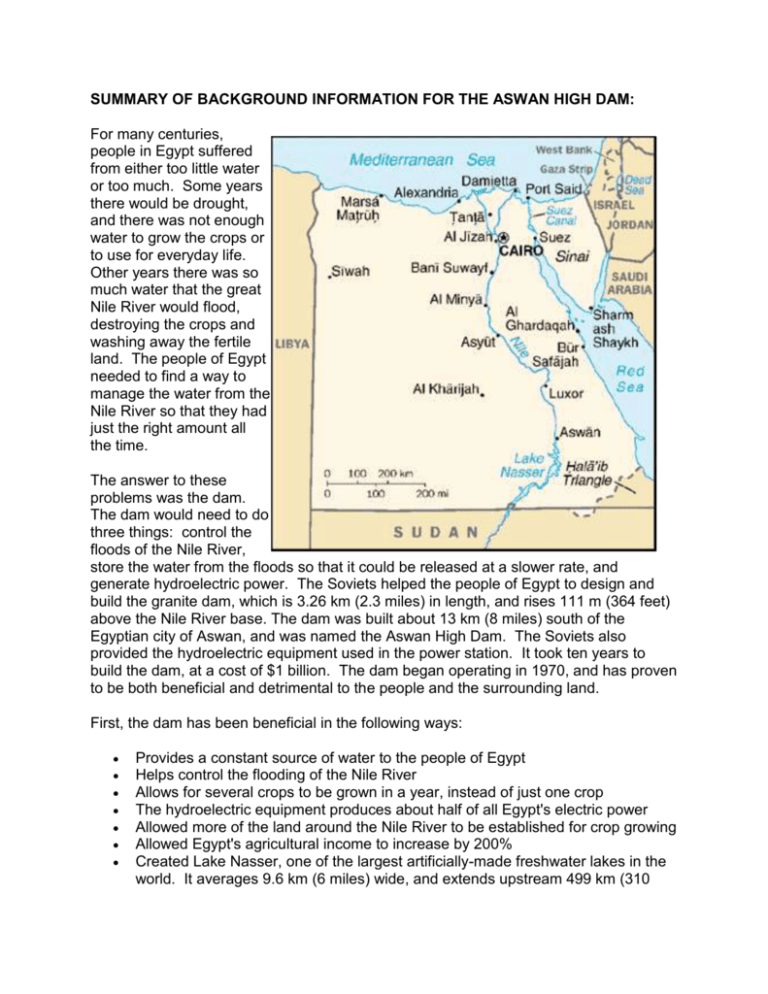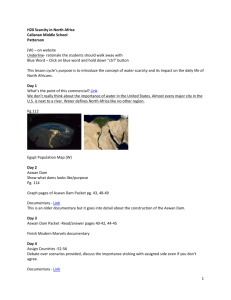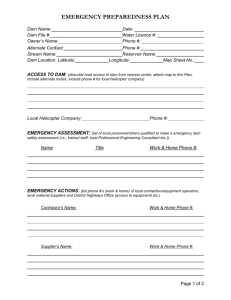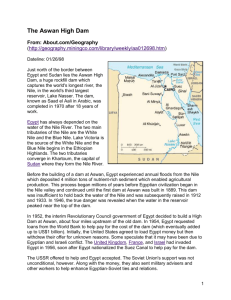SUMMARY OF BACKGROUND on aswan dam
advertisement

SUMMARY OF BACKGROUND INFORMATION FOR THE ASWAN HIGH DAM: For many centuries, people in Egypt suffered from either too little water or too much. Some years there would be drought, and there was not enough water to grow the crops or to use for everyday life. Other years there was so much water that the great Nile River would flood, destroying the crops and washing away the fertile land. The people of Egypt needed to find a way to manage the water from the Nile River so that they had just the right amount all the time. The answer to these problems was the dam. The dam would need to do three things: control the floods of the Nile River, store the water from the floods so that it could be released at a slower rate, and generate hydroelectric power. The Soviets helped the people of Egypt to design and build the granite dam, which is 3.26 km (2.3 miles) in length, and rises 111 m (364 feet) above the Nile River base. The dam was built about 13 km (8 miles) south of the Egyptian city of Aswan, and was named the Aswan High Dam. The Soviets also provided the hydroelectric equipment used in the power station. It took ten years to build the dam, at a cost of $1 billion. The dam began operating in 1970, and has proven to be both beneficial and detrimental to the people and the surrounding land. First, the dam has been beneficial in the following ways: Provides a constant source of water to the people of Egypt Helps control the flooding of the Nile River Allows for several crops to be grown in a year, instead of just one crop The hydroelectric equipment produces about half of all Egypt's electric power Allowed more of the land around the Nile River to be established for crop growing Allowed Egypt's agricultural income to increase by 200% Created Lake Nasser, one of the largest artificially-made freshwater lakes in the world. It averages 9.6 km (6 miles) wide, and extends upstream 499 km (310 miles). The lake is named in honor of Egyptian President Gamal Abdel Nasser, and provides for recreation and a greater fishing industry in the inland regions Development of the fertilizer and metal industries provides jobs and income Made travel between Sudan and Egypt easier Increased the potential for tourism along the Nile River and throughout Egypt Second, the dam has been detrimental in the following ways: Many archaeological sites had to be moved - this cost over $40 million The pressure of the extra water has caused seepage to the surrounding dry land, and has increased the potential for earthquakes in that area About 11% of the water in the dam is lost to evaporation Some disease in the water due to animals and people Since the dam stops the flow of sand and silt, the water downstream carries less nutrients and less sand. Artificial fertilizers now must be used to add nutrients to the soil, and the people who used the sand to make bricks had to excavate agricultural land to get more sand, destroying its use to grow crops. Since the water downstream from the dam flows more slowly, there is greater growth of phytoplankton (small, floating plants that grow in the water) and the water used for drinking has to be treated with greater amounts of chlorine Since there is less water going downstream from the dam, the salt from the Mediterranean Sea has crept slowly inland, making the soil and groundwater saltier than normal. This is harmful to the soil and drinking water, making it unfit to use for growing crops and for drinking and irrigation If the dam should break, millions of people downstream would be killed, and the land would again be flooded Despite the many problems and concerns caused by the dam, most people feel it has been a great success and has helped the Egyptian economy. There is still much room for improvement, and hopefully new technologies will be implemented to make the Aswan High Dam and the Nile River beneficial for all. REFERENCES: 1. Grolier Multimedia Encyclopedia - 1993. Grolier Electronic Publishing. 2. "Environmental Effects of the High Dam at Aswan," an article from the Internet at: http://www.gps.caltech.edu/~ge148/1997C/Reports/148niled.html 3. "The Aswan High Dam," an article from the Internet at: http://www.vol.it/mirror/egypt/Wonders/Modern/aswandam.html









